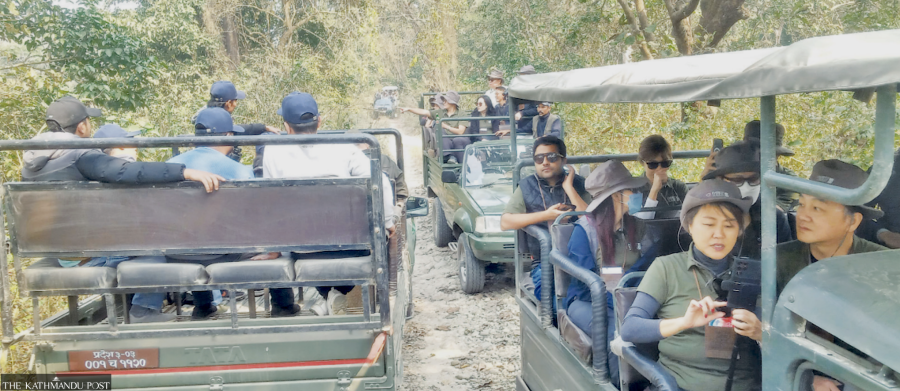Money
Wildlife draws record tourists, alarms conservationists
Chitwan National Park, Nepal’s first national park, drew 306,837 visitors for wildlife activities in the last fiscal year. Among them, 58 percent were Nepalis.
Ramesh Kumar Paudel
The number of tourists visiting Chitwan National Park, Nepal's first wildlife sanctuary, exceeded 300,000 in the last fiscal year that ended last week, which park officials say is the highest-ever footfall.
However, the proportion of tourists visiting the country’s first national park has changed, with nearly 58 percent of visitors to the park being domestic tourists.
The increased numbers have cheered tourism entrepreneurs, but conservationists say that rising footfalls may pose bigger threats to wildlife. They have stressed the need for effective conservation action now more than ever.
The national park is home to tigers, one-horned rhinos, elephants, gharials, birds, and more, but the biggest draw is the famed Royal Bengal tiger.
Ganesh Prasad Tiwari, conservation officer, said 306,837 people visited the park in the last fiscal year, contributing Rs367.29 in revenue. The number of tourists in the previous fiscal year was 299,412, and the revenue was Rs298.96 million.
“Both the tourist numbers and the revenue are the highest.”
Chitwan National Park, established in 1973, is Nepal’s first national park.
Located in the southern central Tarai, the property covers an area of 93,200 hectares and extends over four districts: Chitwan, Nawalparasi, Parsa, and Makwanpur.
It is a habitat of endangered animals such as one-horned rhinos, tigers, gharials, and crocodiles.
Wild elephants, many birds, aquatic animals, and plants are also found here. The tribal Tharu, Bote, Kumal, and Darai live in the park surroundings, and tourists also prefer to observe their culture and lifestyle.
With its rich biodiversity, the park has received several international recognitions for conservation and has, over the years, also gained popularity as a wildlife safari destination.
The park, which relies heavily on tourism revenue, and the hundreds of people who depend on tourism for survival, faced an unprecedented drought in tourism when the Covid pandemic hit Nepal two years ago.
Foreign tourists stopped coming to Chitwan after the Covid-19 pandemic, which inadvertently threatened humans' and animals' livelihoods and survival.
However, officials said that tourism recovered in Chitwan at a fast pace.
The increased footfall brings money but also many challenges, conservationists say.
If the numbers keep rising, there is an emerging risk of habitat degradation, biodiversity loss, increased human-wildlife interaction, and disease transmission, said Tika Giri, a senior conservationist who was a nature guide in 1980. “These need effective conservation action now more than ever before.”
He said there is unhealthy competition in the resorts.
“Undercutting tariff rates in resorts to attract tourists should be stopped. It’s not a healthy way to promote wildlife tourism. Competition should be in providing service, not slashing the rates.”
Giri said that conservation seems to have been neglected after the earthquake, blockade, and the coronavirus lockdown.
Currently, the Jeep Safari, one of the popular activities, is closed due to the monsoon. However, other activities occur in the park's buffer zone, particularly in the community forest areas.
During the tourist season, elephant safaris in the Baghmara Community Forest of Sauraha and jeep and boat safaris on the Rapti river are very popular.
During the tourist season (March-May and September-November), more than 500 people go boating in Narayani and Rapti daily. Similarly, 70 elephants are used for safaris daily.
Although June to August is the slack season due to the monsoon, it has not prevented tourists from visiting the park.
Babita Chaudhary, another hotelier, said that the effect of increased numbers of wildlife goers needs to be seen in business. “The business has grown slightly compared to the Covid period, but there’s not much to cheer about.”
In the last fiscal year, more than half of the park visitors were Nepalis. Of the total tourists, 176,316 were domestic.
The park maintains details of Nepalis, and visitors from the SAARC region and the outer world.
The number of tourists from the third country amounted to 94,050, while there were 36,471 visitors from the SAARC countries.
At one time, more than 60 percent of the tourists visiting the park were foreigners. Chaudhary said that the number of foreign tourists in Chitwan has dropped sharply and requested the government to implement effective marketing and promotional activities in the key source markets.
“The world, including Nepal, is facing an economic slowdown. The roads are in a poor state. In such a situation, there are many challenges.”
The highest number of foreign tourists Chitwan received was in 2014-15. Excluding visitors from SAARC, there were 127,000 foreigners, the highest number recorded so far.
Giri said that wildlife is Chitwan’s tourism attraction. “We need to save our identity. The park and its surrounding forests and environment should be protected. Picnics and dances, which cause disturbances to wildlife, should not be promoted.”
Jagnarayan Bote, the leader of the Bote community who runs a homestay in Chitwan Madi Pandav Nagar, said that expanding tourism in all areas would benefit the locals.
Tourists who visit Chitwan Park enjoy activities such as jeep safari, elephant safari, boat safari, and walking through the forest with an experienced nature guide.
Ganga Giri, president of the Chitwan Sauraha Regional Hotel Association, said that due to the one-way jeep safari route from Sauraha to the park’s west, the crowding has increased, and tourism and wildlife have also been affected.
Tiwari, the park's conservation officer, said they are making arrangements for a new jeep safari route.




 9.12°C Kathmandu
9.12°C Kathmandu1.jpg)













%20(1).jpg&w=300&height=200)
